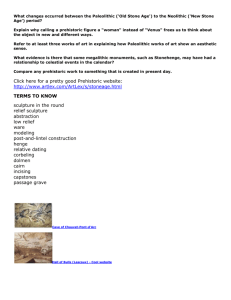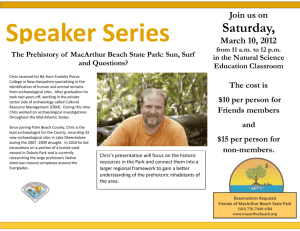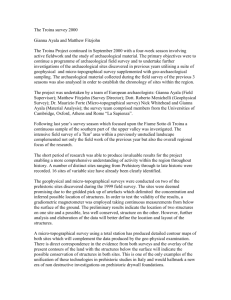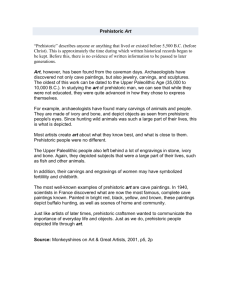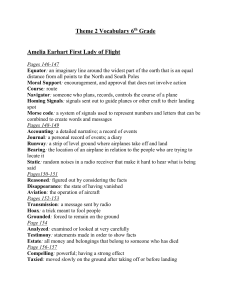Esoteric Knowledge and practical Know-how: inter
advertisement
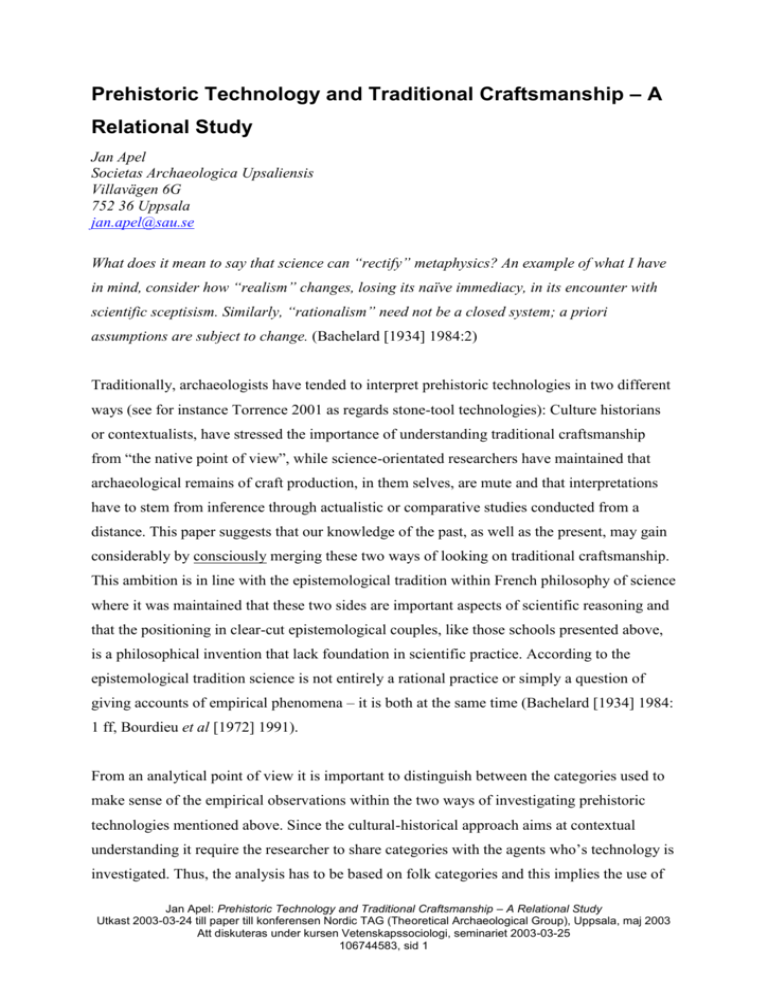
Prehistoric Technology and Traditional Craftsmanship – A Relational Study Jan Apel Societas Archaeologica Upsaliensis Villavägen 6G 752 36 Uppsala jan.apel@sau.se What does it mean to say that science can “rectify” metaphysics? An example of what I have in mind, consider how “realism” changes, losing its naïve immediacy, in its encounter with scientific sceptisism. Similarly, “rationalism” need not be a closed system; a priori assumptions are subject to change. (Bachelard [1934] 1984:2) Traditionally, archaeologists have tended to interpret prehistoric technologies in two different ways (see for instance Torrence 2001 as regards stone-tool technologies): Culture historians or contextualists, have stressed the importance of understanding traditional craftsmanship from “the native point of view”, while science-orientated researchers have maintained that archaeological remains of craft production, in them selves, are mute and that interpretations have to stem from inference through actualistic or comparative studies conducted from a distance. This paper suggests that our knowledge of the past, as well as the present, may gain considerably by consciously merging these two ways of looking on traditional craftsmanship. This ambition is in line with the epistemological tradition within French philosophy of science where it was maintained that these two sides are important aspects of scientific reasoning and that the positioning in clear-cut epistemological couples, like those schools presented above, is a philosophical invention that lack foundation in scientific practice. According to the epistemological tradition science is not entirely a rational practice or simply a question of giving accounts of empirical phenomena – it is both at the same time (Bachelard [1934] 1984: 1 ff, Bourdieu et al [1972] 1991). From an analytical point of view it is important to distinguish between the categories used to make sense of the empirical observations within the two ways of investigating prehistoric technologies mentioned above. Since the cultural-historical approach aims at contextual understanding it require the researcher to share categories with the agents who’s technology is investigated. Thus, the analysis has to be based on folk categories and this implies the use of Jan Apel: Prehistoric Technology and Traditional Craftsmanship – A Relational Study Utkast 2003-03-24 till paper till konferensen Nordic TAG (Theoretical Archaeological Group), Uppsala, maj 2003 Att diskuteras under kursen Vetenskapssociologi, seminariet 2003-03-25 106744583, sid 1 some form of ethno-methodology. This means that if a ethnoarchaeological research strategy is used the anthropologist will strive towards understand the experiences of the peoples that are actually involved in the craft that is studied. Science-orientated archaeologists, on the other hand, strive towards creating instrumental categories since they are of the opinion that the scientific way of classification reveals patterns of which the prehistoric agents themselves were unaware. These two approaches have one thing in common: the interpretations that springs from them claims to be substantial whether they aim at technically orientated descriptions of, or at an understanding of the esoteric rules and regulations that surrounds, traditional technologies. This paper, however, aim towards a relational interpretation of prehistoric technologies (for a discussion of substantial versus relational research strategies, see Bourdieu 1987 & [1972] 1992). Since archaeologists in general are very aware of the fact that few artefacts have substantial value, i.e. an intrinsic value that is independent of their position in the social space of its owner, it is surprising that this awareness of the relational value of things has not resulted in a similar awareness of the relational aspects of other, for instance social, interpretations. By practising a relational archaeology we are permitted to combine the in- and outside perspectives, in analysis as well as in interpretation, and be able to understand specific events in relation to general processes. This may allow us to move beyond both the descriptions of individual, disparate, historical events, leading to an “illusion of transparity” (Bourdieu et al [1972] 1991:109) that the inside perspective produce and the technical, functionalistic descriptions that are the trademark of research conducted according to the outside perspective Before continuing, these two ways of classifying empirical observations will be exemplified by two studies of traditional crafts and especially the way in which they were reproduced through the generations: the production of flint daggers in Scandinavia during the Late Neolithic period and traditional-iron working in Kenya. Both of these technologies were conducted in societies that did not adhere to the economic rules of present day western societies. A preliminary definition of traditional technologies In this context, technology is regarded as a coherent system of artefacts, behaviours and knowledge that can be handed down from one generation to another (Schiffer & Skibo 1987:595). This definition is based on the reproduction of crafts, something that pertains to Jan Apel: Prehistoric Technology and Traditional Craftsmanship – A Relational Study Utkast 2003-03-24 till paper till konferensen Nordic TAG (Theoretical Archaeological Group), Uppsala, maj 2003 Att diskuteras under kursen Vetenskapssociologi, seminariet 2003-03-25 106744583, sid 2 the Neolithic production of daggers as well as the traditional iron making of eastern Africa. The empirical examples that are presented below deals with the organisation of traditional craftsmanship with respect to sequence of gestures and procedures into different stages of production as well as the intra- and inter site spatial distribution of these stages. It is also suggested that traditional technologies in part were vehicles for the reproduction of the social order. It is also assumed that the vehicle for this reproduction is based on kinship. An Experimental and Archaeological study of Late Neolithic Dagger Production in Scandinavia Since it is impossible to study the prehistoric production of daggers at first hand, we are forced to reconstruct the production process by conducting experiment and compare the results with waste products and performs from prehistoric sites. The first important aim for our study of the Late Neolithic dagger production is to define different stages of production that, later on, can be related to the process of apprenticeship. There are two ways of define stages in the production of a flint tool. Seven different production stages Traditional-Iron Working in Kenya The object of study has now been defined. It will now be analysed through a research process involving three steps: Conquest Construction Confirmation A conquest is achieved through a rupture with the folk categories that are connected with the object of study. In the present case we will have to make a clear break with the everyday conceptions that the different peoples involved in these craft traditions might have, i.e. everyday conceptions of flint knapping that archaeologists as well as the flint knappers (prehistoric as well as experimental) might have of the technology in which they are an integral part. Jan Apel: Prehistoric Technology and Traditional Craftsmanship – A Relational Study Utkast 2003-03-24 till paper till konferensen Nordic TAG (Theoretical Archaeological Group), Uppsala, maj 2003 Att diskuteras under kursen Vetenskapssociologi, seminariet 2003-03-25 106744583, sid 3 The construction is achieved by introducing categories that make a clear break with the everyday conceptions Scientific reasoning, the historical epistemologists, Ludwik Fleck, Kuhn, Bourdieu “scientific categories that make a clear break with folk categories”. Dietz Stout’s article One way of making a clear break doing this is to find a way to classify these technologies in a way that will allow us to make use of two concepts that were introduced into archaeology by the French archaeologist Jacques Pelegrin (1990): Knowledge and knowhow. Knowledge an know-how = scientific categories that break with folk categories As regards the traditions presented above, we might be content to make an “account of accounts” (Bourdieu 1987), i.e. to accept the view that it is our role, as archaeologists, to describe how these technologies were regarded within their own context. For instance, concerning traditional-iron production in Kenya, it would make sense to point out that iron making is surrounded by esoteric regulation that may stem from a fear of super natural powers – fire, certain sounds etc – that are involved when iron oxide is transformed into iron. We would also have to accept that the reason for the taboos, for example the prohibition of women to attend the area around the furnace during smelting – is due to the belief that the presence of women will poison the ore and make it useless. There it might be of the production of iron as it is presented to us by informants and by observation. As I see it, this is a typical We all know that every object that we own, no matter how insignificant it may seem, not only answers practical needs but also carries a social message. Pencils, cars, gloves or trousers all contain these aspects. While it may be important to recognise that the division between the reproduction of an ideal “past in the present” and a more universal, everyday, practical behaviour – “the present” – is an academic reduction of reality it does not follow that the Jan Apel: Prehistoric Technology and Traditional Craftsmanship – A Relational Study Utkast 2003-03-24 till paper till konferensen Nordic TAG (Theoretical Archaeological Group), Uppsala, maj 2003 Att diskuteras under kursen Vetenskapssociologi, seminariet 2003-03-25 106744583, sid 4 demarcation of these categories is useless. On the contrary, scientific reductions are necessary tools for the archaeologist in that they tend to reveal patterns that are not obvious and therefore difficult to appreciate by the common sense. The Maurice Bloch has demonstrated how these two modes of cognition may work within a continuous process rather than as two opposites. Maurice Bloch has argued convincingly that different ways speech is used in different social situations. Thus speech acts are used in private conversation while a formalised language is predominant in the public sphere. Bloch argues that there is a continuum in which communication from repetitive (formalised) communication to generative (everyday) communication represents two ends (Bloch 1989:22 ff.). For instance, ritual communication is formalised and repetitive, while everyday language stems from Once we avoid the temptation to try only to understand how the prehistoric agents experienced their world, and thus making “accounts of accounts“ (Bourdieu 1987), and instead put a real effort into creating scientific categories that break with folk categories, the point may very well be reached when the distance between them and us, cultural as well as chronological, disappear. The knowledge gained through studying material remains of people in other contexts may then be used in order to study aspects of our own society. This is when we realise that the symbolic economy in evidence in the traditional technologies is uncomfortably familiar. Thus, it may now be time for archaeologists, engaged in material culture studies, to leave the subject of archaeology to those that are content to continuously interpret an re-interpret cultural history through their senses, in combination with “unique” contexts of the archaeological materials, and instead develop a study of material culture that may help us to understand our selves through our relations to things. Such studies would indeed Jan Apel: Prehistoric Technology and Traditional Craftsmanship – A Relational Study Utkast 2003-03-24 till paper till konferensen Nordic TAG (Theoretical Archaeological Group), Uppsala, maj 2003 Att diskuteras under kursen Vetenskapssociologi, seminariet 2003-03-25 106744583, sid 5

